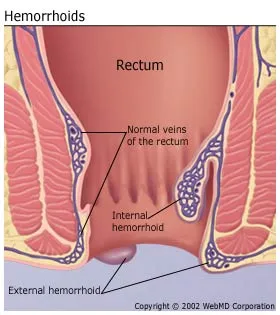Medi Services

Hemorrhoids (HEM-uh-roids), also called piles, are swollen and inflamed veins in your anus and lower rectum. Hemorrhoids may result from straining during bowel movements or from the increased pressure on these veins during pregnancy, among other causes. Hemorrhoids may be located inside the rectum (internal hemorrhoids), or they may develop under the skin around the anus (external hemorrhoids).
Hemorrhoids are common ailments. By age 50, about half of adults have had to deal with the itching, discomfort and bleeding that can signal the presence of hemorrhoids.
Fortunately, many effective options are available to treat hemorrhoids. Most people can get relief from symptoms by using home treatments and making lifestyle changes.
They're swollen blood vessels of the rectum. The hemorrhoidal veins are located in the lowest area of the rectum and the anus. Sometimes they swell so that the vein walls become stretched, thin, and irritated when you have bowel movements.

Internal hemorrhoids lie far enough inside the rectum that you can't see or feel them. They don't usually hurt because there are few pain-sensing nerves in the rectum. Bleeding may be the only sign they're there.
Sometimes internal hemorrhoids "prolapse," or enlarge and protrude outside the anal sphincter. When this happens, you may be able to see or feel them as moist, pink pads of skin that are pinker than the surrounding area. Prolapsed hemorrhoids may hurt because the anus is dense with pain-sensing nerves. They usually go back into the rectum on their own. If they don't, they can often be gently pushed back into place.External hemorrhoids lie within the anus. They're usually painful. If they move, or prolapse, to the outside (usually when you have a bowel movement), you can see and feel it.
Blood clots sometimes form within prolapsed external hemorrhoids, causing a very painful condition called a thrombosis. If that happens, the hemorrhoid can turn purple or blue, and could possibly bleed. Despite its appearance, it's usually not serious, apart from the pain. It will go away in a couple of weeks. Your doctor can remove it if the pain is unbearable.
You should get any anal bleeding and pain checked by a doctor to make sure it’s not a more serious condition. Hemorrhoids are the No. 1 cause of this type of bleeding and are rarely dangerous, but you should find out for sure.
Doctors don’t know the exact cause. Some people may be more likely to get them because they have “weak" veins, leading to hemorrhoids and other varicose veins. That may be something you inherit.
There are other possibilities, too. It's likely that extreme abdominal pressure makes the veins swell and become likelier to get irritated. The pressure can be caused by:
Hemorrhoids are swollen veins located around the anus or in the lower rectum. The Mayo Clinic reports that about half of adults have experienced the symptoms of hemorrhoids by the age of 50.
Hemorrhoids can either be internal or external. Internal hemorrhoids develop within the anus or rectum. External hemorrhoids develop outside of the anus. Hemorrhoids are also known as piles.
Of the two forms of hemorrhoids, external hemorrhoids are the most common and the most troublesome. Hemorrhoids cause pain, severe itching, and difficulty sitting. The good news is that they’re treatable.
What Are the Symptoms of Hemorrhoids?The symptoms of hemorrhoids include:
Although hemorrhoids are painful, they aren’t life-threatening and often go away on their own without treatment. If you have them often, you may develop symptoms of anemia such as weakness and pale skin due to blood loss, though this is rare.
You’re also more likely to develop hemorrhoids if you’re pregnant. When the uterus enlarges, it presses on the vein in the colon causing it to bulge.
How Are Hemorrhoids Diagnosed?A visual examination of your anus may be enough to diagnose hemorrhoids. To confirm the diagnosis, your doctor may wish to do a different examination to check for any abnormalities within the anus. This check is known as a digital rectal exam. During this exam, your doctor inserts a gloved and lubricated finger into your rectum. If they feel anything abnormal, they may order an additional test called a sigmoidoscopy.
A sigmoidoscopy involves your doctor using a small camera to diagnose an internal hemorrhoid. This small fiber-optic camera, called a sigmoidoscope, fits into a small tube and then inserts into your rectum. From this test, your doctor gets a clear view of the inside of your rectum so that they can examine the hemorrhoid up close.